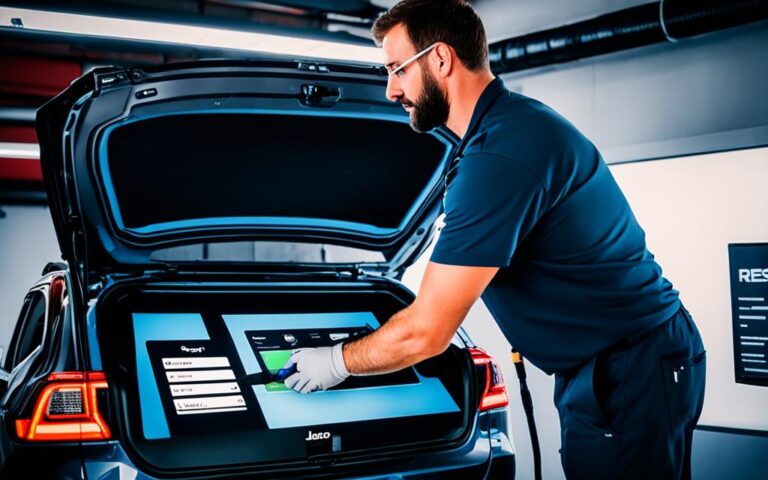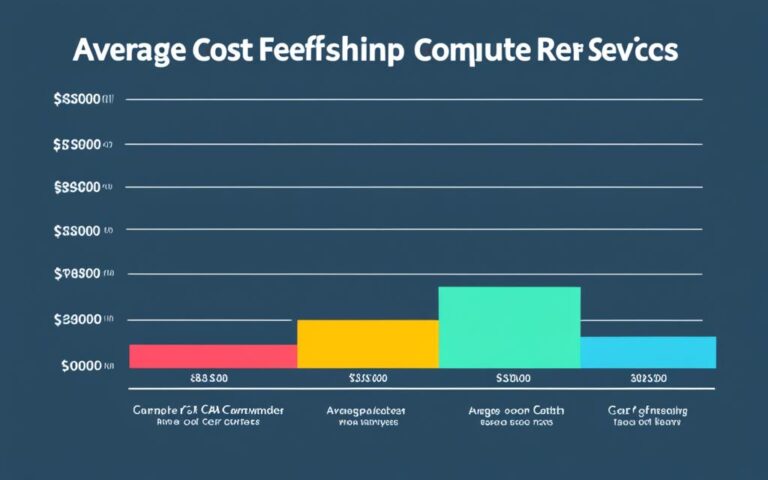Computer-Assisted Personal Interviews (CAPI) are a key way to collect and analyse data. They involve face-to-face interviews where people use devices like tablets or phones to record answers. CAPI has many benefits, like using logic checks and skip patterns to improve data quality1. It also lets you upload data in real-time and check it often, making sure the data is right1.
But, CAPI has its downsides, especially in places where power and internet are not reliable. These issues can make it hard to use CAPI well, so you need to plan carefully. Also, you need interviewers who know how to use technology, which might be tricky in some areas1.
There are many software options for CAPI. Some top choices include Blaise by Statistics Netherlands, CSPro by the United States Census Bureau, Dooblo by Dooblo Ltd., Israel, Open Data Kit (ODK) by the University of Washington, SurveyBe by Economic Development Initiatives Limited, UK, and SurveySolutions by The World Bank1.
Choosing the right hardware is important for a smooth CAPI process. For most surveys, a 7-inch tablet is best. But, if your survey is complex, a 10-inch tablet might be better1. It’s also good to have tablets with at least 1 GB of storage. You can add more space with SD cards if you need to store many questionnaires1.
Key Takeaways:
- CAPI has benefits like logic checks and real-time data upload, which improve data quality1.
- But, CAPI relies on electricity and internet and needs interviewers who are tech-savvy1.
- For CAPI, you can choose from software like Blaise, CSPro, Dooblo, ODK, SurveyBe, and SurveySolutions1.
- For most surveys, a 7-inch tablet is best. But, use a 10-inch tablet for complex surveys1.
- Make sure tablets have at least 1 GB of storage and can expand with SD cards if needed1.
Advantages of CAPI
CAPI, or Computer-Assisted Personal Interviewing, is a powerful tool for collecting data. It helps researchers gather high-quality data efficiently. By using CAPI technology, researchers can make sure their data is accurate. They can also improve responses and keep an eye on how enumerators work.
- Real-time data validation and skip pattern logic during interviews increase efficiency and reduce errors in data collection2.
- CAPI enables a wide range of question types, including rating scales, date pickers, and multimedia questions, generating more detailed and comprehensive data2.
- Manual data entry becomes unnecessary, as CAPI allows for direct transfer of data into a digital format for easy analysis with statistical software packages3.
- Enumerator monitoring is facilitated through features that record interview start time, end time, and GPS location, enabling supervisors to verify enumerator conduct and ensure data accuracy2.
- Immediate data upload in electronic format enables real-time analysis and frequent quality checks, enhancing the overall data quality2.
But, it’s important to know the downsides of using CAPI. It can be costly, needing investments in equipment and software2. Also, interviewers need a good internet connection and to know the software well, which might be hard in places with bad internet2. To fix these issues, companies like GeoPoll have made tools like the GeoPoll Interviewer App. This app helps collect data affordably and offline until the internet comes back2.
CAPI has many benefits for collecting data, like better accuracy, detailed answers, and keeping an eye on enumerators. But, it’s key to think about the costs and internet problems when using CAPI. With careful planning and the right tools, the good points of CAPI can be big.
| Advantages of CAPI |
|---|
| Enhanced data accuracy |
| Detailed responses |
| High response rates |
| Handling of complex surveys |
| Immediate data access |
| Flexibility with multimedia |
| Improved engagement |
| Data security |
Reference:
- GeoPoll – Computer-Assisted Personal Interviewing (CAPI)
- NCBI – Integrated Biological and Behavioural Surveillance using
- FieldworkHub – CAPI in Quantitative Market
Disadvantages of CAPI
CAPI has many benefits, but it also has some downsides. It’s key to think about these when planning and using CAPI surveys.
Challenges in Crime-Ridden Areas
In areas hit hard by crime, CAPI surveys face hurdles. There’s a risk of thieves stealing tablets or phones. Surveyors must stay alert and protect their gear and data4.
Dependency on Electricity and Data Connectivity
CAPI needs a steady power supply and reliable data connection. This might not be possible in remote or unstable areas. This can limit where CAPI surveys can go and affect how data is collected5.
Data Corruption Risks
There’s a chance of data corruption in CAPI surveys. If data gets damaged before it’s saved or backed up, it could be lost forever. It’s vital to have strong data management to reduce the risk of losing data4.
Limitations with Qualitative Information and Comments
CAPI might not be the best for getting detailed info or comments from people. The digital interface can limit how deep and rich responses are. This makes CAPI less good for interviews that need more open-ended talks5.
Concerns about Privacy and Data Security
People might worry about their personal data being accessed without permission in a CAPI survey. This could impact how good and trustworthy the data is. It’s crucial to tackle these worries and make sure data is kept safe6.
| Statistical Data | Source |
|---|---|
| Respondents may face difficulties in understanding the content, structure, and workings of CAPI questionnaires | Bulmer et al. (1998)6 |
| Blyth (1998) mentioned additional challenges with CAPI, including equipment costs, software issues, and the need for batteries | Blyth (1998)6 |
| Human errors in CAPI may lead to consistent serious errors affecting every interview | Collins & Sykes (1998)6 |
CAPI Software Options
Researchers have many choices when it comes to CAPI software. They can pick from SurveyCTO, Blaise, CSPro, Dooblo, Open Data Kit (ODK), SurveyBe, and SurveySolutions7. Each software has its own set of features, letting researchers tailor surveys to their needs.
SurveyCTO is a top choice, built on the Open Data Kit (ODK) platform7. It gives researchers a full set of tools for collecting, managing, and analyzing data. This ensures surveys are run efficiently and accurately.
Blaise and CSPro are also well-known7. They capture data well, including text, numbers, pictures, and audio. They also help guide interviewers through surveys smoothly.
Dooblo makes customizing surveys easy7. Researchers can change survey layouts, designs, and branding. This makes the experience better for both interviewers and those being surveyed.
Open Data Kit (ODK) is open-source and flexible7. It lets researchers create and use surveys on many devices, like Android phones and tablets. ODK also works with analysis tools for better data processing.
SurveyBe and SurveySolutions are also good options7. SurveyBe is easy to use and includes multimedia features. SurveySolutions focuses on keeping data quality high.
Choosing the right CAPI software is key. Look at things like data capture, ease of navigating questionnaires, data quality control, compatibility with analysis tools, and case management. By picking the best software, researchers can make their surveys more effective.
| CAPI Software | Key Features |
|---|---|
| SurveyCTO | Comprehensive suite of tools for efficient survey administration7 |
| Blaise | Robust data capture capabilities and questionnaire navigation7 |
| CSPro | Diverse data capture options and flexible survey customization7 |
| Dooblo | Easy survey customization and personalized user experience7 |
| Open Data Kit (ODK) | Open-source platform for flexible and versatile data collection7 |
| SurveyBe | Emphasis on ease of use and multimedia integration7 |
| SurveySolutions | Data quality control measures and reliable data collection7 |
Hardware Considerations for CAPI
Choosing the right hardware is key for a successful CAPI data collection. You need to think about tablet selection, connectivity, screen size, and battery life. These factors are crucial for a smooth process.
When picking tablets, make sure they fit the survey needs and field conditions. Tablets are great for collecting data because they’re portable and easy to use. They have bigger screens than phones, making reading and answering questions easier. Most surveys use tablets that are 7 inches or 10 inches big8.
Good connectivity is vital for sending data in real-time. Tablets with Wi-Fi and cellular can send data anywhere, even in places without stable Wi-Fi8.
The size of the tablet screen matters too. A bigger screen makes showing survey questions and answers clearer. This makes the experience better for both the person giving the survey and the person answering it9.
Battery life is also important. Fieldworkers often work for a long time without a break. A tablet with a long battery life means you won’t run out of power in the middle of collecting data9.
Think about the tablet’s storage too. You’ll need enough space to store all the data from the survey. This ensures you have room for everything you need during the survey period8.
Tablets with cameras are useful for adding multimedia to your surveys. They let you record audio or video, giving you more detailed information9.
It’s also good to have an Android tablet. Make sure it’s running the latest Android version. This supports the newest survey software and apps8.
GPS is another thing to consider. Tablets with GPS can pinpoint where survey answers come from. It also helps keep an eye on fieldworkers and cuts down on errors by using maps for sampling9.
By looking at these points, you can pick the best hardware for CAPI. This ensures your data collection goes smoothly and meets your survey’s needs.
| Consideration | Hardware | Reference |
|---|---|---|
| Tablet Selection | 7 inches or 10 inches | 8 |
| Connectivity | Wi-Fi and Cellular | 8 |
| Screen Size | Larger for better readability | 9 |
| Battery Life | Long lasting | 9 |
| Storage Capacity | Adequate for the survey period | 8 |
| Camera | Front and back cameras | 9 |
| Operating System | Up-to-date Android | 8 |
| GPS Functionality | Built-in GPS | 9 |
Steps and Considerations for Planning and Executing a Successful CAPI Project
Planning and executing a successful CAPI project needs careful thought. It’s important to follow certain steps and think about key factors. This ensures the project goes smoothly.
- First, decide on the project’s goals and why CAPI is better than other methods. Look at time, cost, and scope. Use stats to show how CAPI cuts down on time, costs, and boosts data quality10.
- Then, plan the project timeline with important milestones from start to finish. This keeps everything on track. Make sure to allow enough time for testing, collecting data, and processing it10.
- Next, pick the right CAPI software for collecting and analyzing data. Think about what the software can do, how reliable it is, and if it works with different devices and systems. SurveyCTO is a top choice for CAPI surveys, offering lots of features and support1.
- For data collection in the field, choose the right hardware. Look at memory, screen size, battery life, and how it connects to the internet. Cheap netbooks have made collecting data easier and cheaper1011.
- Then, find and train the right people for the project. They should know the language, understand the culture, know the subject, and be tech-savvy. The project’s success depends on the team’s skills and hard work. Make sure your team can do the job well101.
- Finally, test the survey before collecting real data. This is key to finding and fixing problems early. It helps make sure the data is good quality and trustworthy10.
In conclusion, planning and doing a CAPI project right is crucial. By following these steps and thinking about these factors, organizations can use CAPI well. This leads to efficient and quality data collection.
Categorizing CAPI Surveys
CAPI surveys can be split into two types: named and anonymous. Each type has its own way of picking samples, collecting data, and choosing who answers the survey.
Named CAPI Surveys
In named CAPI surveys, people are chosen before the survey starts. This means they know when to come and their details are ready. It makes the survey more efficient and accurate.
This method lets researchers talk directly to specific people. It can help build trust and might get more answers. The interviews are face-to-face, so answers are clear and detailed12. It also means answers come back right away, skipping the step of typing them in12. But, it works best in certain areas where meeting in person is easy12.
Anonymous CAPI Surveys
Anonymous CAPI surveys pick people randomly and check them right away. This way, they can reach more people in a certain area. People aren’t known before the survey, and they’re chosen on the spot.
This method can reach a wide range of people13. But, it might be hard to find the right people and make sure they understand the questions, especially in places without good internet13. Still, it’s cheaper and easier than other ways like talking or phone surveys13.
| Survey Type | Advantages | Disadvantages |
|---|---|---|
| Named CAPI Surveys | – Pre-identified respondents for targeted data collection – Accurate responses due to face-to-face interactions – Immediate response time |
– Geographical limitation – Time-consuming for data collection in larger areas |
| Anonymous CAPI Surveys | – Broad coverage of geographical area and target audience – Cost-effective and less effort required for data collection |
– Challenges in identifying the target audience – Potential difficulties in ensuring understanding of survey questions in areas with limited internet access |
By dividing CAPI surveys into named and anonymous types, researchers can match their methods to their goals and who they want to reach. Knowing the good and bad of each type helps make surveys work well.
Next, we’ll look at how audio-CASI and video-CASI improve surveys. These technologies make the survey better and help collect more data.
The Importance of Audio-CASI and Video-CASI in CAPI
Audio-CASI and Video-CASI are key in Computer-Assisted Personal Interviewing (CAPI). They make collecting data better and make the experience for respondents better too.
Audio-CASI lets people hear the questions instead of reading them. This helps those who struggle with reading and keeps their answers private. It makes sure people can answer truthfully without feeling watched14. It’s great for people who find reading hard, making sure everyone can take part and give reliable answers.
Video-CASI uses videos and images to make questions clearer and more engaging. This keeps people interested and helps them understand better14. Videos and pictures make complex topics clearer, leading to better data.
Both Audio-CASI and Video-CASI are preferred by respondents. A study showed that people who find reading hard prefer these over traditional paper surveys14. These methods work well even for those not familiar with computers14.
People liked Audio-CASI more than Video-CASI for being interesting and easy to use14. Audio-CASI is great at keeping people engaged and easy to use. It’s perfect for surveys that need to keep people interested and easy to follow.
Audio-CASI also makes surveys better for people who struggle with reading14. It lets everyone take part, avoiding the problems that reading skills can cause. This is very useful for surveys in places where reading skills vary.
Using Audio-CASI and Video-CASI needs careful thought about technology, logistics, and what the respondents like. To get the most out of these methods, researchers and experts should think about who they are surveying, what they want to know, and what they can use.
References:
Conclusion
Computer-Assisted Personal Interviewing (CAPI) is a powerful way to collect data. It uses electronic devices in interviews to check answers and keep an eye on interviewers. This makes the data more accurate and reliable15. But, it’s key to know the downsides like security risks and issues with infrastructure and what respondents might think13.
To make a CAPI project work well, picking the right software and hardware is crucial. You also need to plan carefully and train your interviewers15. New tech like voice recognition and augmented reality could make CAPI even better in the future15.
Statistics Canada’s CAPI Monitoring Program helps check data quality and train staff. It also makes collecting data on different topics easy and cheap13. Yet, finding the right people for surveys and making sure they’re tech-savvy can be hard, especially in areas with poor internet access13.
In short, CAPI is a flexible tool for gathering data. By knowing what each situation needs and taking steps to protect against risks, researchers can use CAPI to get quality data and make smart choices1513.
FAQ
What is Computer-Assisted Personal Interviewing (CAPI)?
CAPI is a way to collect data where an interviewer uses a device like a tablet or computer. They record answers during the interview.
What are the advantages of CAPI?
CAPI has many benefits. It helps with checking answers and skipping certain questions. It also makes sure data is correct and uploads it quickly.
What are the disadvantages of CAPI?
CAPI has some downsides. It needs electricity and internet, which might not always be available. It can also be risky and requires interviewers to know how to use technology.
What are some popular CAPI software options?
Some top CAPI software choices are SurveyCTO, Blaise, CSPro, Dooblo, Open Data Kit (ODK), SurveyBe, and SurveySolutions.
What hardware considerations should be taken into account for CAPI?
When picking hardware for CAPI, think about internet and phone connectivity. Also, consider cameras, the Android system, size, storage, screen quality, GPS, font support, and battery life.
What steps and considerations are necessary for planning and executing a successful CAPI project?
For a successful CAPI project, set clear goals and explain why you’re using CAPI. Plan the timeline, choose the right software and hardware, train your team, and test the survey first.
How can CAPI surveys be categorized?
CAPI surveys can be either named or anonymous. The type depends on how you choose to sample your participants.
What is the importance of Audio-CASI and Video-CASI in CAPI?
Audio-CASI helps by asking questions out loud, making it easier for everyone to answer. Video-CASI uses videos to help people understand questions better. Both methods improve data quality and make respondents more comfortable.
What is the summary of CAPI as a data collection method?
CAPI is a method that uses devices to record answers in face-to-face interviews. It has benefits like checking answers and watching interviewers. But, it also has risks and needs certain conditions to work well.
Source Links
- https://dimewiki.worldbank.org/Computer-Assisted_Personal_Interviews_(CAPI) – Computer-Assisted Personal Interviews (CAPI) – Dimewiki
- https://www.geopoll.com/blog/computer-assisted-personal-interviewing-capi/ – Computer-Assisted Personal interviewing (CAPI) – Process, Benefits & Limitations – GeoPoll
- https://fieldworkhub.com/methods/quantitative-market-research/capi/ – CAPI market research agency – Quantitative research method
- https://www.beamfieldwork.co.uk/computer-assisted-personal-interviewing-the-pros-cons/ – Computer Assisted Personal Interviewing: Pro’s & Cons – BEAM Fieldwork
- https://sru.soc.surrey.ac.uk/SRU3.html – Social Research Update 3: Computer Assisted Personal Interviewing
- https://iassistquarterly.com/public/pdfs/iqvol232forster.pdf – vol23/2
- https://www.voxco.com/blog/a-short-guide-to-capi-survey-software/ – A Short Guide to CAPI Survey Software
- https://www.younglives.org.uk/sites/www.younglives.org.uk/files/GuidetoYLResearch-S13-CAPI.pdf – PDF
- https://www.surveypractice.org/article/2781-using-tablet-computers-to-implement-surveys-in-challenging-environments – Using Tablet Computers to Implement Surveys in Challenging Environments | Published in Survey Practice
- https://www.nass.usda.gov/Education_and_Outreach/Reports,_Presentations_and_Conferences/reports/USDA-NASS James M Harris and Michael W Gerling Research Report.pdf – PDF
- https://www.fcsm.gov/assets/files/docs/spwp19.pdf – Statistical Policy Working Paper 19 – Computer Assisted Survey Information Collection
- http://marketgenics.co/2020/11/capi-research-method-the-basic-concept-of-capi/ – CAPI Research Method : The basic concept of CAPI – MarketGenics
- https://ertcegypt.com/blog/capi-survey/ – What is capi survey?, capi survey, survey capi, capi surveys | ERTC
- https://www.ncbi.nlm.nih.gov/pmc/articles/PMC3279921/ – AUDIO AND VIDEO COMPUTER-ASSISTED SELF INTERVIEWING: Preliminary Tests of New Technologies for Data Collection
- https://beaninterviewgenius.com/articles/enhancing-data-collection-efficiency-through-capi-computer-assisted-personal-interviews/ – Enhancing Data Collection Efficiency through CAPI: Computer Assisted Personal Interviews – Be an Interview Genius


















